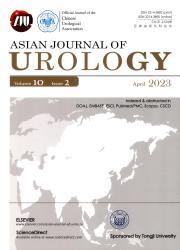Ketamine-associated upper urinary tract dysfunction: What we know from current literature
IF 2.4
3区 医学
Q2 UROLOGY & NEPHROLOGY
引用次数: 0
Abstract
Objective
To review the current literature on ketamine-associated upper urinary tract (UUT) dysfunction and provide an overview of its pathogenesis and treatment principles.
Methods
A literature search was conducted using PubMed and Cochrane databases for relevant articles published in English between 2008 and 2023. Keywords used included “ketamine” and “upper urinary tract”.
Results
A total of 22 papers were included. Relatively few studies have focused on ketamine-associated UUT dysfunction. Exclusion criteria included lack of hydronephrosis, or pathological findings. After careful screening and exclusion, we finally adopted 11 of these papers and analyzed them. Ketamine-associated UUT dysfunction may be a concern in this field.
Conclusion
Ketamine abuse can lead to UUT impairment and dysfunction, with symptoms such as bladder dysfunction and contracted bladder with vesicoureteral reflux, direct damage and barrier dysfunction, inflammation, apoptosis, fibrosis and stricture, and papillary necrosis. Oxidative stress, autophagy, and microvascular injury are also potential pathogenic mechanisms. The detection of these symptoms largely depends on laboratory and imaging examinations. The treatment principles of ketamine-associated UUT dysfunction are protecting the UUT, improving bladder dysfunction, and resuming normal social life. More investigations are needed to clarify the mechanisms and shed light on the treatment of ketamine-associated UUT damage.
氯胺酮相关的上尿路功能障碍:我们从目前的文献中了解到的
目的回顾氯胺酮相关性上尿路功能障碍的相关文献,综述其发病机制及治疗原则。方法利用PubMed和Cochrane数据库检索2008 - 2023年发表的相关英文文献。关键词包括“氯胺酮”和“上尿路”。结果共纳入论文22篇。相对较少的研究关注氯胺酮相关的UUT功能障碍。排除标准包括无肾积水或病理表现。经过仔细的筛选和排除,我们最终采纳了其中的11篇论文并进行了分析。氯胺酮相关的UUT功能障碍可能是该领域的一个关注点。结论氯胺酮滥用可导致UUT损伤和功能障碍,表现为膀胱功能障碍、膀胱膀胱收缩伴膀胱输尿管反流、直接损伤和屏障功能障碍、炎症、细胞凋亡、纤维化和狭窄、乳头状坏死等。氧化应激、自噬和微血管损伤也是潜在的致病机制。这些症状的发现在很大程度上取决于实验室和影像学检查。氯胺酮相关性UUT功能障碍的治疗原则是保护UUT、改善膀胱功能障碍、恢复正常社交生活。需要更多的研究来阐明其机制,并阐明氯胺酮相关UUT损伤的治疗方法。
本文章由计算机程序翻译,如有差异,请以英文原文为准。
求助全文
约1分钟内获得全文
求助全文
来源期刊

Asian Journal of Urology
UROLOGY & NEPHROLOGY-
CiteScore
4.00
自引率
3.80%
发文量
100
审稿时长
4 weeks
期刊介绍:
Asian Journal of Urology (AJUR), launched in October 2014, is an international peer-reviewed Open Access journal jointly founded by Shanghai Association for Science and Technology (SAST) and Second Military Medical University (SMMU). AJUR aims to build a communication platform for international researchers to effectively share scholarly achievements. It focuses on all specialties of urology both scientifically and clinically, with article types widely covering editorials, opinions, perspectives, reviews and mini-reviews, original articles, cases reports, rapid communications, and letters, etc. Fields of particular interest to the journal including, but not limited to: • Surgical oncology • Endourology • Calculi • Female urology • Erectile dysfunction • Infertility • Pediatric urology • Renal transplantation • Reconstructive surgery • Radiology • Pathology • Neurourology.
 求助内容:
求助内容: 应助结果提醒方式:
应助结果提醒方式:


